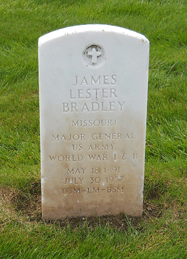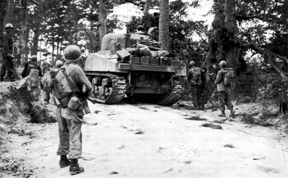James L. Bradley married Pauline Clarkson. James and Pauline had only one daughter, Mildred. Pauline preceded James in death in 1949.

Major General Bradley retired in 1947.
On 30 July 1957, James Bradley died of drowning in a swimming pool at his daughter's home in Lafayette, CA. He had been under treatment for a heart ailment. His daughter, Mildred, found him in the pool and is his only survivor.
His body is buried in San Francisco National Cemetery
From Find a Grave LINK
|
|
Biography
James Lester Bradley was born to Spencer Price and Mary Watts Bradley on 18 May 1891, in Doniphan, Missouri.
James was a Cadet at the U. S. Military Academy at West Point from 1 March 1910 to 12 June 1914, when he graduated and was commissioned a Second Lieutenant in the U.S. Army Infantry and assigned to the 19th Infantry Regiment. During his time at West Point, he became friends with a Cadet in the Class of 1915, named Dwight David Eisenhower.
He served at: Vera Cruz, Mexico, 18 Sept – 25 Nov 1914; Galveston, TX, to 3 Dec 1914; Naco and Douglas, AZ, with 22nd Infantry, to 3 Feb 1915; Galveston, TX, with regiment, to 18 Sep 1915; Del Rio, TX, Camp and District Adjutant, to 4 June 1916; Fort Sam Houston, TX, Acting and Battalion Adjutant, to 1 June 1917, when he was transferred to 57th Infantry; Camp Travis, TX, to 10 July 1917; Camp Stanley, TX, to 7 Oct 1917; McAllen, TX, Commanding post to 24 Oct 1917; Fort Sill, OK, Student Officer at Infantry School of Arms to 25 Nov 1917, when he graduated; Brownsville, TX, 27-30 Nov; at Fort Sill, OK, Instructor at Infantry School of Arms to 5 Oct 1918; Camp Benning, GA, Secretary of Infantry School of Arms.
During this period, Bradley received promotions to First Lieutenant,
19th Infantry, 1 July 1916; Captain, 19th Infantry, 15, May 1917; and Major of Infantry, National Army, 17 June 1918.
Other assignments included: Command and General Staff School in 1925; Army War College in 1930; and Instructor, Command and General Staff School in 1932.
He was promoted to Colonel in 1940 and served first as Assistant Chief of Staff, 4th Army, then as Chief of Staff, 4th Army.
At Camp Adair August 15, 1942, in a simple Activation ceremony General Bradley addressed his men.
|
“We of the 96th Division have a clearly defined task. It is to become a well trained combat division in the shortest time possible. We must keep our eyes, our thoughts on that goal. Any time spent on efforts which do not lead to that goal is time wasted and we have no time to waste.
This is the kind of division we are going to be: a well trained, tough physically and mentally ready and eager to fight, not for personal glory or advancement, but for the honor of the division and the service of our country.
|
|
"We kill or we get killed” |
Bradley was promoted to Brigadier General in Sept 1941 and to Major General in June 1942. He became Commanding General of the 96th Infantry Division when it was activated on 15 Aug 1942, and commanded the division through its entire existence in World War II; it was deactivated on 3 Feb 1946.
He was awarded the Distinguished Service Medal for “exceptional meritorious service to the government in a duty of great responsibility.
|
General Bradley and the 96th Infantry Division
|
The 96th Division was activated in September 1942 at Camp Adair, Oregon, with Maj. General James L Bradley commanding. The Division trained raw men for twenty months in all kinds of conditions to be infantrymen. All up and down the line command officers and men learned how to work together and were focused on the ultimate mission to take out the Japanese. No US Army General had created a better killing machine from scratch; and history will prove the fact; Gen Bradley was a gifted leader and tactician.
|
The division embarked from Camp Stoneman, California in July 1944 for battle in the Pacific. They were subsequently assigned to the XXIV Corps and General Hodge, all under Gen. MacArthur for the attack on Leyte, Philippines.
|
General MacArthur visits the Division command post. General Hodge is at the left, General Bradley is at the right.
|
They made an amphibious landing on Blue Beach, on Oct 20th near Dulag. It was here the men proved up to the task, slogging through swamps and muck, sleeping in fox-holes filled with water, evading snipers, insects, leaches, malaria, fungus, snakes, spraying machine guns, artillery shrapnel and night-time infiltrating Japanese soldiers, then systematically day by day searching and killing the enemy, in, behind and over rocky crests, bushes, elephant grass, hills, rocks and groves of coconut trees. It was kill or be killed time and the island had to be taken.
These Bradley-trained Deadeyes were also inspired to perpetual revenge after learning that their defenseless wounded buddies in a small army hospital had been sadistically bludgeoned to death.
When the battle was over, over 500 Deadeyes had lost their lives, hundreds lie wounded in hospitals, 48,790 Japanese were killed on Leyte,,and 7,700 Japanese had been killed on Okinawa.. Combined American forces had secured the island by December and eliminated 25,000 enemy troops. This is bloody warfare, and Deadeyes prevailed.
Deadeyes were soon preparing for the battle of Okinawa; the chain of command changed. Admiral Spruance was given the Okinawa assignment by Admiral Nimitz, and Gen Buckner commanded the land battle directing all Marine forces, with Gen Hodges and the XXIV Corp with Gen Bradley in command of the 96th.
|
General Bradley tells his staff the startling news - the Division will by-pass Yap, and instead land on Leyte
|
Deadeyes made an amphibious landing on beaches April 1st, 1945 spreading eastward and then turning south with few casualties. They were a part of a combined force of six infantry divisions in a viscous battle to secure the island for the ultimate victory over Japan.
|
This was a colossal battle; 300,000 Americans against 110,000 Japanese, in spring like weather and torrential rain.
Japanese forces were ready and each crest was bristling with enemy soldiers and weaponry. Caves and elaborate tunnels were filled with troops, mortars, artillery and machine guns registered to deliver cross fire
Thousands of American soldiers were wounded and killed in hand to hand battles securing that important territory, which figure includes the death of 1400 Deadeyes and scores more wounded.
Deadeyes were in some of the biggest battles and were ultimately recognized for destroying over 30,000 enemy troops. They earned over 200 silver stars, hundreds of Bronze Stars, and Purple Hearts. |
|
Click images for larger pictures

|
Supporting units earned meritorious service and battle honors, and the Division was awarded the prestigious Presidential Unit Citation. Deadeyes were also individually cited by Generals Buckner and Hodge.
Gen Easley was his next in command and Regimental Commanders Colonel Michael Halloran, Macey Dill, and Edwin May proved to be outstanding leaders. Col May and Easley were most unfortunately killed in battle.
The division shipped to Mindoro in a typhoon and learned of the atom bombs enroute. Soon the war was over and it meant Deadeyes would not be invading Japan. They were not chosen for occupation troops and it was thought that Deadeyes had too many bitter memories for a job requiring tolerance.
The division returned home in December and was soon deactivated. General Bradley and his men had served honorably and distinctly and completed the task.
|
|